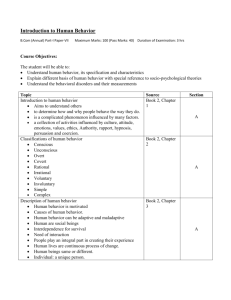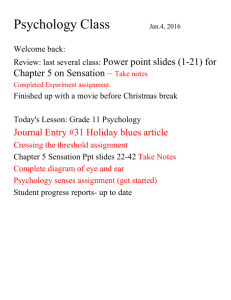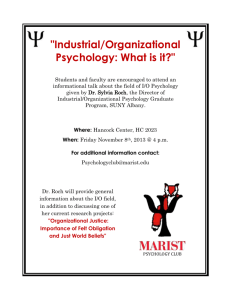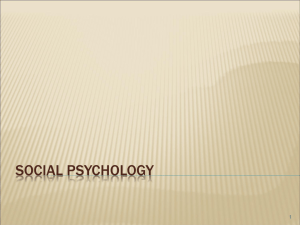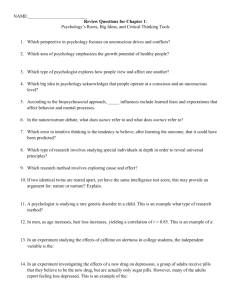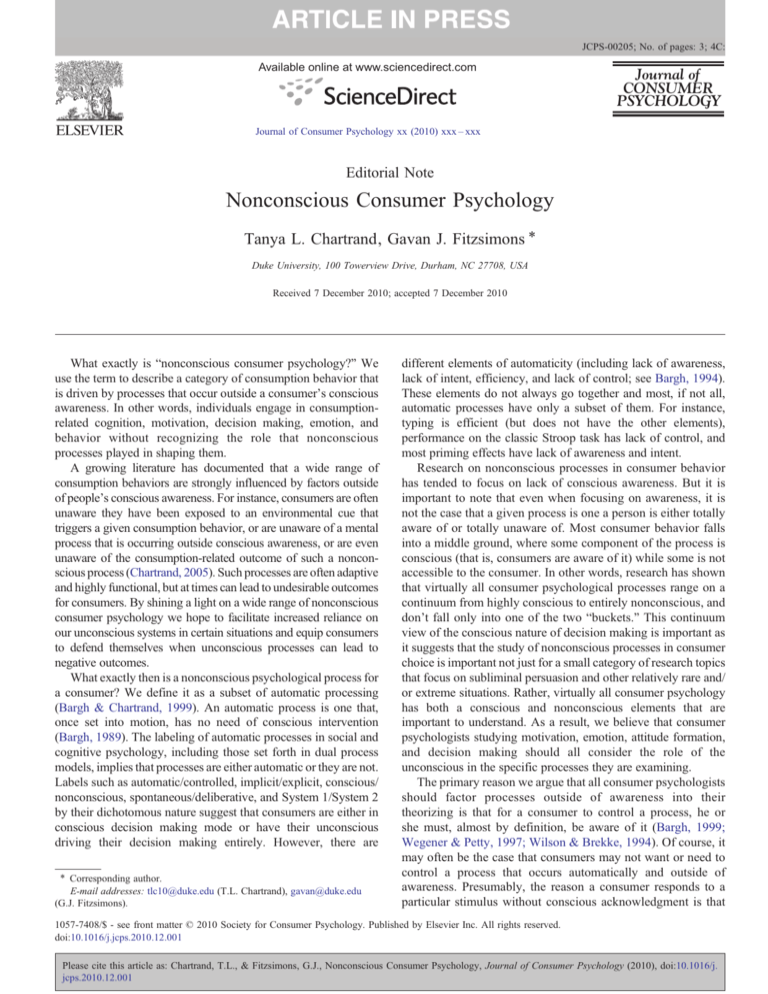
JCPS-00205; No. of pages: 3; 4C:
Available online at www.sciencedirect.com
Journal of
CONSUMER
PSYCHOLOGY
Journal of Consumer Psychology xx (2010) xxx – xxx
Editorial Note
Nonconscious Consumer Psychology
Tanya L. Chartrand, Gavan J. Fitzsimons ⁎
Duke University, 100 Towerview Drive, Durham, NC 27708, USA
Received 7 December 2010; accepted 7 December 2010
What exactly is “nonconscious consumer psychology?” We
use the term to describe a category of consumption behavior that
is driven by processes that occur outside a consumer's conscious
awareness. In other words, individuals engage in consumptionrelated cognition, motivation, decision making, emotion, and
behavior without recognizing the role that nonconscious
processes played in shaping them.
A growing literature has documented that a wide range of
consumption behaviors are strongly influenced by factors outside
of people's conscious awareness. For instance, consumers are often
unaware they have been exposed to an environmental cue that
triggers a given consumption behavior, or are unaware of a mental
process that is occurring outside conscious awareness, or are even
unaware of the consumption-related outcome of such a nonconscious process (Chartrand, 2005). Such processes are often adaptive
and highly functional, but at times can lead to undesirable outcomes
for consumers. By shining a light on a wide range of nonconscious
consumer psychology we hope to facilitate increased reliance on
our unconscious systems in certain situations and equip consumers
to defend themselves when unconscious processes can lead to
negative outcomes.
What exactly then is a nonconscious psychological process for
a consumer? We define it as a subset of automatic processing
(Bargh & Chartrand, 1999). An automatic process is one that,
once set into motion, has no need of conscious intervention
(Bargh, 1989). The labeling of automatic processes in social and
cognitive psychology, including those set forth in dual process
models, implies that processes are either automatic or they are not.
Labels such as automatic/controlled, implicit/explicit, conscious/
nonconscious, spontaneous/deliberative, and System 1/System 2
by their dichotomous nature suggest that consumers are either in
conscious decision making mode or have their unconscious
driving their decision making entirely. However, there are
⁎ Corresponding author.
E-mail addresses: tlc10@duke.edu (T.L. Chartrand), gavan@duke.edu
(G.J. Fitzsimons).
different elements of automaticity (including lack of awareness,
lack of intent, efficiency, and lack of control; see Bargh, 1994).
These elements do not always go together and most, if not all,
automatic processes have only a subset of them. For instance,
typing is efficient (but does not have the other elements),
performance on the classic Stroop task has lack of control, and
most priming effects have lack of awareness and intent.
Research on nonconscious processes in consumer behavior
has tended to focus on lack of conscious awareness. But it is
important to note that even when focusing on awareness, it is
not the case that a given process is one a person is either totally
aware of or totally unaware of. Most consumer behavior falls
into a middle ground, where some component of the process is
conscious (that is, consumers are aware of it) while some is not
accessible to the consumer. In other words, research has shown
that virtually all consumer psychological processes range on a
continuum from highly conscious to entirely nonconscious, and
don't fall only into one of the two “buckets.” This continuum
view of the conscious nature of decision making is important as
it suggests that the study of nonconscious processes in consumer
choice is important not just for a small category of research topics
that focus on subliminal persuasion and other relatively rare and/
or extreme situations. Rather, virtually all consumer psychology
has both a conscious and nonconscious elements that are
important to understand. As a result, we believe that consumer
psychologists studying motivation, emotion, attitude formation,
and decision making should all consider the role of the
unconscious in the specific processes they are examining.
The primary reason we argue that all consumer psychologists
should factor processes outside of awareness into their
theorizing is that for a consumer to control a process, he or
she must, almost by definition, be aware of it (Bargh, 1999;
Wegener & Petty, 1997; Wilson & Brekke, 1994). Of course, it
may often be the case that consumers may not want or need to
control a process that occurs automatically and outside of
awareness. Presumably, the reason a consumer responds to a
particular stimulus without conscious acknowledgment is that
1057-7408/$ - see front matter © 2010 Society for Consumer Psychology. Published by Elsevier Inc. All rights reserved.
doi:10.1016/j.jcps.2010.12.001
Please cite this article as: Chartrand, T.L., & Fitzsimons, G.J., Nonconscious Consumer Psychology, Journal of Consumer Psychology (2010), doi:10.1016/j.
jcps.2010.12.001
2
Editorial Note
this response has proven favorable over the course of their lives
(and even over human history). Put differently, much of our
unconscious consumer processing is likely to be quite adaptive
and functional. In such situations, the consumer need not be
concerned. These processes save precious conscious cognitive
resources in a world of increasingly taxed individuals. But when
the nonconscious system leads to an undesirable outcome, a
consumer can only avoid this outcome if he or she is aware that
the process is occurring in the first place. By more broadly
studying such processes and perhaps developing response or
control strategies, consumer welfare can be substantially
enhanced.
results of which are published in psychology journals. In part,
this is due to the incredibly broad nature of the consumption
arena, which cuts across motivation, emotion, attitude formation, judgment and decision making, information processing,
and behavior. But it is likely also the case that consumption has
proven to be such a popular context in which to study
nonconscious processes because so much of our consumption
behavior is driven by such processes. Moreover, it is a domain
in which the relevance for our daily lives is evident. Everyone
consumes — many times a day — and it is easy to see the
practical implications of these nonconscious processes in our
daily consumption and how they affect us in powerful ways.
A brief history of the nonconscious in consumer psychology
Motivation for and overview of the special issue
It was not that long ago that the use of the term nonconscious (or
unconscious) to describe consumer psychology was essentially
verboten. Perhaps researchers were (too) comfortable with the
traditional information processing models implying that consumer
behavior is driven by conscious, deliberative thought and choice.
Perhaps some were unaware of the virtual revolution of
automaticity in social psychology over the last several decades.
Perhaps consumer psychologists, along with many consumers, did
not want to acknowledge that many of the processes that occur in a
consumption domain occur largely outside the awareness of the
consumer. In 2001 a group of 12 researchers gathered in a research
track at the Choice Symposium to talk about their belief that the
unconscious played an important, or some might say critical, role
in forwarding our understanding of consumer psychology
(Fitzsimons et al., 2002). It was emboldening to (i) hear that
other researchers were working on related research ideas centered
around nonconscious processes and (ii) learn that none of us were
alone in experiencing strong resistance from consumer research
gatekeepers (e.g., editors and editorial boards) to the notion that
key processes in consumption were often largely nonconscious.
In the 10 years since that conference there has been an explosion
of research on consumption being driven by processes occurring
outside conscious awareness. It is rare to see an issue of the Journal
of Consumer Psychology (or any other top tier consumer behavior
outlet) that does not have multiple articles that in one way or
another examine nonconscious consumer psychology. The field
has transformed to a point where most scholars simply take the
critical role of nonconscious processes in consumer psychology as a
given.
Although nonconscious consumer psychology largely began
with researchers applying established findings and methodological tools from the fields of social and cognitive psychology
to the domain of consumption, it has become clear that consumption is not “just another domain” in which one can apply
these ideas. Rather, the consumption setting has proven to play
a fundamental role in the nonconscious space, as evidenced by
more and more social and cognitive psychologists studying
nonconscious processes in the consumer domain. In fact, some
of the most important theoretical advances in the field of
nonconscious processes more generally have been published in
consumer journals such as JCP. Those in the basic disciplines,
particularly social psychology, often follow up the work, the
When the editor asked us to co-edit this special issue on
nonconscious processes in consumer psychology, we thought it
would provide a great opportunity to showcase how far the field
has come in such a short time. Our goal with this special issue was
to capture a snapshot of where current thinking is on nonconscious
processes in consumer domains, and the contributors to this
special issue have done a superb job at providing an accurate
overview of some of the key issues being investigated in the field.
They also nicely illustrate how nonconscious processes are so very
boundary-crossing in current research practices.
Two of the articles explore the topic of “unconscious thought,”
a thought process that occurs without conscious attention, which
has previously been shown to lead to benefits versus more traditional (conscious) thinking approaches to solving a problem (e.g.,
Dijksterhuis & Nordgren, 2006). In this issue, Bos, Dijksterhuis,
and van Baaren explore the mechanism underlying the unconscious thought effect and find support for an unconscious attribute
weighting process. Messner and Wanke explore the role of
unconscious thought in situations with high and low levels of
assortment availability. They find that classic information overload
effects (Iyengar & Lepper, 2000) actually reverse under conditions
of unconscious thought, and that high assortments yield the most
satisfied consumers.
Many of the contributions focus one way or another on the
effects of exposure to environmental stimuli on consumers. Two
articles deal explicitly with the complex way that exposure to one
stimulus can influence consumers through the activation of
related constructs. Wheeler and Sleeth–Keepler show that
incidental exposure to consumer products can activate a given
construct, and that consumers will behave in accordance with that
construct unless a second activated construct is inconsistent with
the primary activation. Dimofte and Yalch find that indirect
associations shared by dissimilar constructs can be simultaneously activated and influence one another despite no direct link
between them. A third article on exposure effects by Fishbach,
Ratner and Zhang examines how nonconscious activation of a
positive framing of repetitive behaviors (e.g., loyalty) led to very
different effects on subsequent behavior than a negative framing
of the same behavior (e.g., boredom). In an article that focuses
more on the motivational side of nonconscious exposure,
Veltkamp, Custers, and Aarts show that nonconscious pairing
Please cite this article as: Chartrand, T.L., & Fitzsimons, G.J., Nonconscious Consumer Psychology, Journal of Consumer Psychology (2010), doi:10.1016/j.
jcps.2010.12.001
Editorial Note
of a stimulus with positive affect can indeed lead to behavioral
change, even in conditions of no motivation prior to exposure.
Two of the articles deal with the special case of incidental
exposure to products in naturalistic settings, or product placements.
Brasel and Gips look at performance effects of nonconscious
exposure to an arousing brand name in the context of a racing video
game and find both facilitation and interference, depending on
game context. Hang and Auty explore the role of product placements on perceptual and conceptual fluency and identified a key
moderator: whether children had an opportunity to directly interact
with the brand in the gaming context.
In a shift from nonconscious processes triggered by exposure
from an external source to internally oriented aspects of the
consumer's self-evaluation, two of the articles examine the role of
nonconscious processes in the interaction between the self and the
environment. Roedder-John and Park explore how discrepancies
between explicit and implicit self-esteem can lead to changes in
materialism, and find that when implicit and explicit self-esteem
diverge consumers are likely to become more materialistic.
Forehand, Perkins and Reed examine when consumers are likely
to contrast versus assimilate to age-based information in an
advertisement and find that deliberative processing of the ad
information leads to very different contrast/assimilation patterns
than does impulsive processing of the ad. Their results suggest an
important interaction between consumer processing style and
assimilation style effects.
Finally, Kramer and Block contribute an article examining
the nonconscious nature of consumer “peculiar beliefs.” They
connect literatures on contagion effects to those on superstition
and present a series of interesting propositions on how peculiar
beliefs will operate in consumption domains more generally.
Concluding comments
The first wave of research studying nonconscious processes
in consumer domains largely demonstrated that a process could
occur outside conscious awareness. The next wave of research
has evolved to study how different nonconscious processes
3
interact with each other and with conscious processes. The 11
articles featured in this special issue are great illustrations of this
second wave of research in nonconscious consumer psychology.
Consumer psychologists no longer simply demonstrate, for example, that priming a consumer can change their behavior. Instead,
we seek to understand how that prime operates, or use the basic
notion of nonconscious exposure to better understand substantive
phenomenon in the lives of consumers. It is our hope that this
special issue will spur more research on the important role that the
unconscious plays in the lives of consumers and in doing so
improve both researcher understanding as well as consumer
welfare.
References
Bargh, J. A. (1989). Conditional automaticity: varieties of automatic influence
on social perception and cognition. In J. Uleman, & J. Bargh (Eds.),
Unintended thought. New York: Guilford.
Bargh, J. A. (1994). The four horsemen of automaticity: awareness, intention,
efficiency, and control in social cognition. In R. S. WyerJr., & T. K. Srull
(Eds.), Handbook of social cognition (pp. 1−40). (2nd ed.). Hillsdale, NJ:
Lawrence Erlbaum Associates, Inc.
Bargh, J. A. (1999). The cognitive monster: the case against the controllability
of automatic sterotype effects. In Chaiken, & Trope (Eds.), Dual-process
theories in social psychology. New York: Guilford.
Bargh, J. A., & Chartrand, T. L. (1999). The unbearable automaticity of being.
American Psychologist, 54, 462−479.
Chartrand, T. L. (2005). The role of conscious awareness in consumer behavior.
Journal of Consumer Psychology, 15, 203−210.
Dijksterhuis, A., & Nordgren, L. (2006). A theory of unconscious thought.
Perspectives on Psychological Science, 1, 95−109.
Fitzsimons, G. J., Hutchinson, J. W., Alba, J. W., Chartrand, T. L., Huber, J.,
Kardes, F. R., et al. (2002). Non- conscious influences on consumer choice.
Marketing Letters, 13(3), 267−277.
Iyengar, S., & Lepper, M. (2000). When choice is demotivating: can one desire
too much of a good thing? Journal of Personality a nd Social Psychology,
79, 995−1006.
Wegener, D., & Petty, R. (1997). The flexible correction model: the role of naive
theories of bias in bias correction. Advances in Experimental Social
Psychology, 29, 141−208.
Wilson, T., & Brekke, N. (1994). Mental contamination and mental correction:
unwanted influences on judgments and evaluations. Psychological Bulletin, 116,
117−142.
Please cite this article as: Chartrand, T.L., & Fitzsimons, G.J., Nonconscious Consumer Psychology, Journal of Consumer Psychology (2010), doi:10.1016/j.
jcps.2010.12.001

